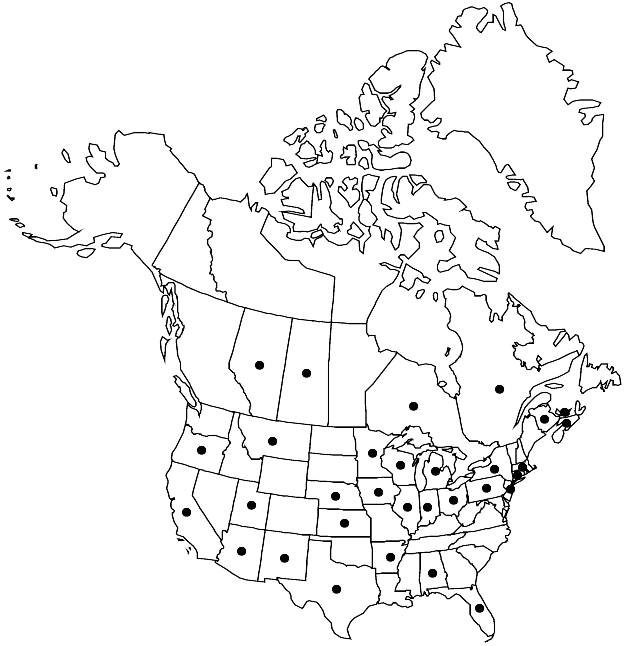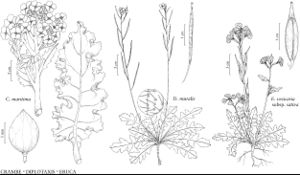Difference between revisions of "Diplotaxis muralis"
Syst. Nat. 2: 634. 1821.
FNA>Volume Importer |
FNA>Volume Importer |
||
| Line 30: | Line 30: | ||
|elevation=80-2000 m | |elevation=80-2000 m | ||
|distribution=Alta.;N.B.;N.S.;Ont.;P.E.I.;Que.;Sask.;Ala.;Ariz.;Ark.;Calif.;Conn.;Fla.;Ill.;Ind.;Iowa;Kans.;Mass.;Mich.;Minn.;Mont.;Nebr.;N.J.;N.Mex.;N.Y.;Ohio;Oreg.;Pa.;Tex.;Utah;Wis.;Eurasia;Africa;introduced also in Mexico (Coahuila;Nuevo León);West Indies (Bahamas);Bermuda;South America;Pacific Islands (New Zealand);Australia. | |distribution=Alta.;N.B.;N.S.;Ont.;P.E.I.;Que.;Sask.;Ala.;Ariz.;Ark.;Calif.;Conn.;Fla.;Ill.;Ind.;Iowa;Kans.;Mass.;Mich.;Minn.;Mont.;Nebr.;N.J.;N.Mex.;N.Y.;Ohio;Oreg.;Pa.;Tex.;Utah;Wis.;Eurasia;Africa;introduced also in Mexico (Coahuila;Nuevo León);West Indies (Bahamas);Bermuda;South America;Pacific Islands (New Zealand);Australia. | ||
| − | |discussion=<p>Diplotaxis muralis was introduced from Europe as a ballast plant in the last century and may have failed to persist in some of the recorded provinces and states. It is an allopolyploid arisen from D. tenuifolia and the Eurasian D. viminea (Linnaeus) de Candolle with 2n = 20 (M. D. Sánchez-Yélamo and J. B. Martínez-Laborde 1991; K. Mummenhoff et al. 1993; G. Eschmann-Grupe et al. 2003). There does not seem to be a sound basis for attributing D. viminea to the flora area, as done by V. I. Dorofeev (1998), because most specimens cited by him belong, in fact, to D. muralis.</p> | + | |discussion=<p><i>Diplotaxis muralis</i> was introduced from Europe as a ballast plant in the last century and may have failed to persist in some of the recorded provinces and states. It is an allopolyploid arisen from <i>D. tenuifolia</i> and the Eurasian D. viminea (Linnaeus) de Candolle with 2n = 20 (M. D. Sánchez-Yélamo and J. B. Martínez-Laborde 1991; K. Mummenhoff et al. 1993; G. Eschmann-Grupe et al. 2003). There does not seem to be a sound basis for attributing D. viminea to the flora area, as done by V. I. Dorofeev (1998), because most specimens cited by him belong, in fact, to <i>D. muralis</i>.</p> |
|tables= | |tables= | ||
|references= | |references= | ||
| Line 55: | Line 55: | ||
|publication year=1821 | |publication year=1821 | ||
|special status= | |special status= | ||
| − | |source xml=https://jpend@bitbucket.org/aafc-mbb/fna-data-curation.git/src/ | + | |source xml=https://jpend@bitbucket.org/aafc-mbb/fna-data-curation.git/src/8f726806613d60c220dc4493de13607dd3150896/coarse_grained_fna_xml/V7/V7_650.xml |
|tribe=Brassicaceae tribe Brassiceae | |tribe=Brassicaceae tribe Brassiceae | ||
|genus=Diplotaxis | |genus=Diplotaxis | ||
Revision as of 17:59, 18 September 2019
Annuals or perennials, (short-lived, frequently scapose or subscapose, taprooted), strongly scented (with glucosinolates). Stems ascending to suberect, (0.5–)2–5(–6) dm, moderately pubescent (trichomes predominantly patent basally, retrorse distally to near racemes). Basal leaves (rosulate); blade elliptic to obovate, 2–9 cm × 10–35 mm, margins sinuate to pinnatifid, lyrate, [2–4(–6) lobes each side], (margins and veins glabrescent to sparsely pubescent). Cauline leaves shortly petiolate to sessile; blade margins entire or dentate. Fruiting pedicels (3–)8–20(–37) mm. Flowers: sepals 3–5.5 mm, pubescent or glabrous, trichomes straight; petals yellow, 5–8(–10) × 3–5 mm; filaments 3.5–6 mm; anthers 1.5–2 mm; gynophore obsolete or to 0.5 mm. Fruits erect-patent, (1.5–)2–4 cm × 1.5–2.5 mm; terminal segment beaklike, (1–)1.5–3 mm, seedless; (ovules 20–36 per ovary). Seeds 0.9–1.3 × 0.6–0.9 mm. 2n = 42.
Phenology: Flowering spring–fall.
Habitat: Waste ground, disturbed or cultivated soil, ballast places, wharves, roadsides, railroads, around buildings, grazed grasslands
Elevation: 80-2000 m
Distribution

Alta., N.B., N.S., Ont., P.E.I., Que., Sask., Ala., Ariz., Ark., Calif., Conn., Fla., Ill., Ind., Iowa, Kans., Mass., Mich., Minn., Mont., Nebr., N.J., N.Mex., N.Y., Ohio, Oreg., Pa., Tex., Utah, Wis., Eurasia, Africa, introduced also in Mexico (Coahuila, Nuevo León), West Indies (Bahamas), Bermuda, South America, Pacific Islands (New Zealand), Australia.
Discussion
Diplotaxis muralis was introduced from Europe as a ballast plant in the last century and may have failed to persist in some of the recorded provinces and states. It is an allopolyploid arisen from D. tenuifolia and the Eurasian D. viminea (Linnaeus) de Candolle with 2n = 20 (M. D. Sánchez-Yélamo and J. B. Martínez-Laborde 1991; K. Mummenhoff et al. 1993; G. Eschmann-Grupe et al. 2003). There does not seem to be a sound basis for attributing D. viminea to the flora area, as done by V. I. Dorofeev (1998), because most specimens cited by him belong, in fact, to D. muralis.
Selected References
None.
